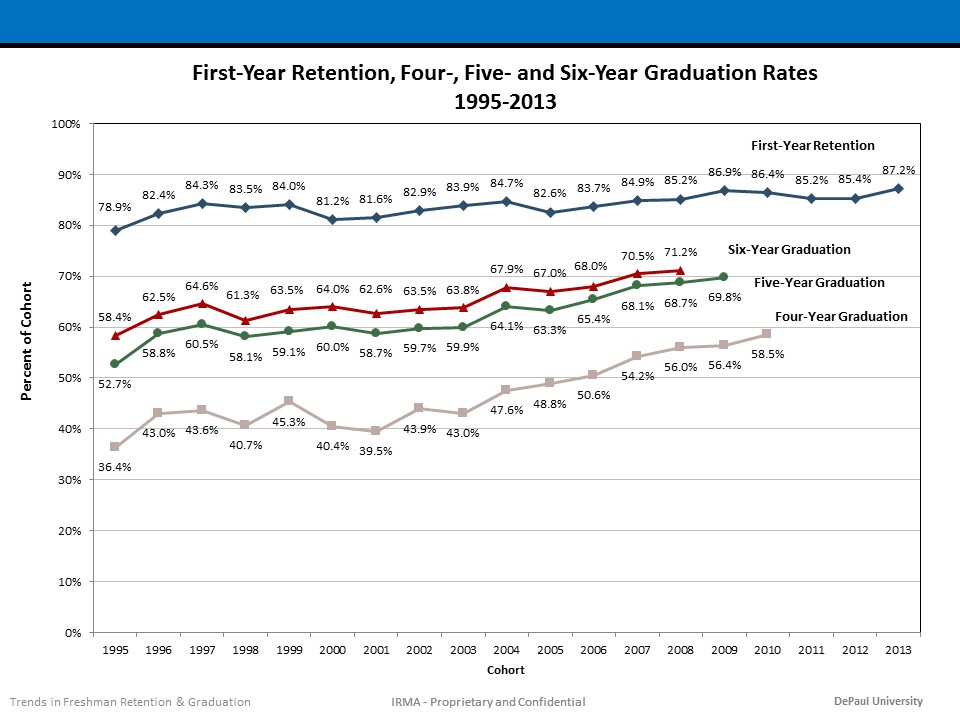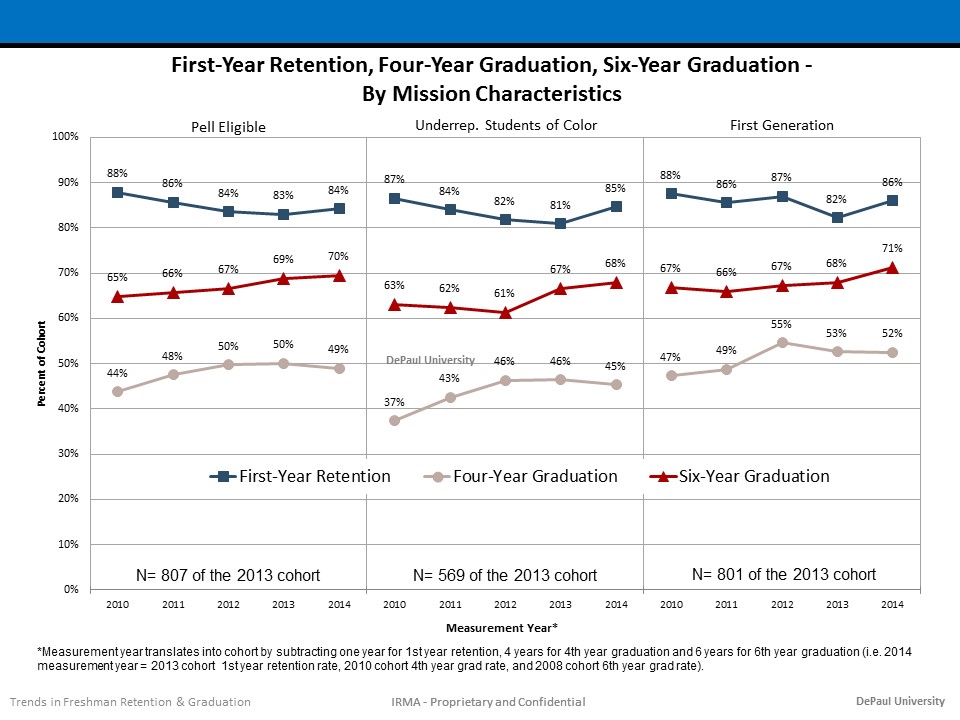Rates for first-year retention, four-year graduation and six-year graduation at DePaul have been consistently strong in recent years, but new data reported by EMM’s Institutional Research and Market Analytics (IRMA) demonstrate they reached new heights in 2014: all rates are the highest in DePaul’s history.
 Click to enlarge graph illustrating DePaul’s retention and graduation rates from 1995 to 2013 (most recent data available).
Click to enlarge graph illustrating DePaul’s retention and graduation rates from 1995 to 2013 (most recent data available).
Highlights of DePaul’s rates (which reflect data for first-time, full-time, degree-seeking freshmen) include:
- First‐year retention increased to 87 percent. This represents a 1.8 percentage point increase over last year.
- The four‐year graduation rate is up to 58 percent. The four‐year graduation rate has steadily increased by 15.5 percentage points from the cohort that graduated in 2007.
- The six‐year graduation rate is 71 percent, the second year in a row that it has exceeded 70 percent. While the measure is over six years,
the average time to degree for these students was actually about four years and one quarter.
Not only have retention and graduation outcomes improved overall, but they have also improved among student populations that are central to DePaul’s mission—and tend to have lower retention and graduation rates by national and state standards. These populations include federal Pell Grant eligible students (a primary indicator for low-income); first-generation students; and/or underrepresented students of color (African-American, Hispanic/Latino, and American Indian). First-year retention and six-year graduation rates increased for all three of these populations (see chart below).
 Graph illustrating DePaul’s retention and graduation rates by mission characteristics.
DePaul’s outcomes compare very favorably with other institutions. Its rates for first-year retention and six-year graduation have exceeded the averages for private four-year institutions around the country for about 15 years—and the difference is not insignificant. DePaul’s first-year retention rate in 2013 (the most recent year for which national data is available) was 11 points above the average first-year retention rate of 74 percent for private four-year institutions, while DePaul’s average six-year graduation rate was 10 percentage points above the national average of 60 percent.* And DePaul now ranks 17th in the nation among doctoral institutions on the U.S. News and World Report’s Graduation Rate Performance measure, which measures how much the graduate rate exceeds what would be predicted given the student profile.
Retention and graduation rates for transfer students are forthcoming and will be reported later this winter.DePaul’s Executive Retention Group (XRG) oversees the university’s retention strategy. Data and other information developed for the XRG are available on the Student Retention at DePaul
Graph illustrating DePaul’s retention and graduation rates by mission characteristics.
DePaul’s outcomes compare very favorably with other institutions. Its rates for first-year retention and six-year graduation have exceeded the averages for private four-year institutions around the country for about 15 years—and the difference is not insignificant. DePaul’s first-year retention rate in 2013 (the most recent year for which national data is available) was 11 points above the average first-year retention rate of 74 percent for private four-year institutions, while DePaul’s average six-year graduation rate was 10 percentage points above the national average of 60 percent.* And DePaul now ranks 17th in the nation among doctoral institutions on the U.S. News and World Report’s Graduation Rate Performance measure, which measures how much the graduate rate exceeds what would be predicted given the student profile.
Retention and graduation rates for transfer students are forthcoming and will be reported later this winter.DePaul’s Executive Retention Group (XRG) oversees the university’s retention strategy. Data and other information developed for the XRG are available on the Student Retention at DePaul website
. For additional questions about DePaul’s retention and graduation rates, contact
Liz Holder. *Source: ACT National Collegiate Retention & Persistence to Degree Report, 2014